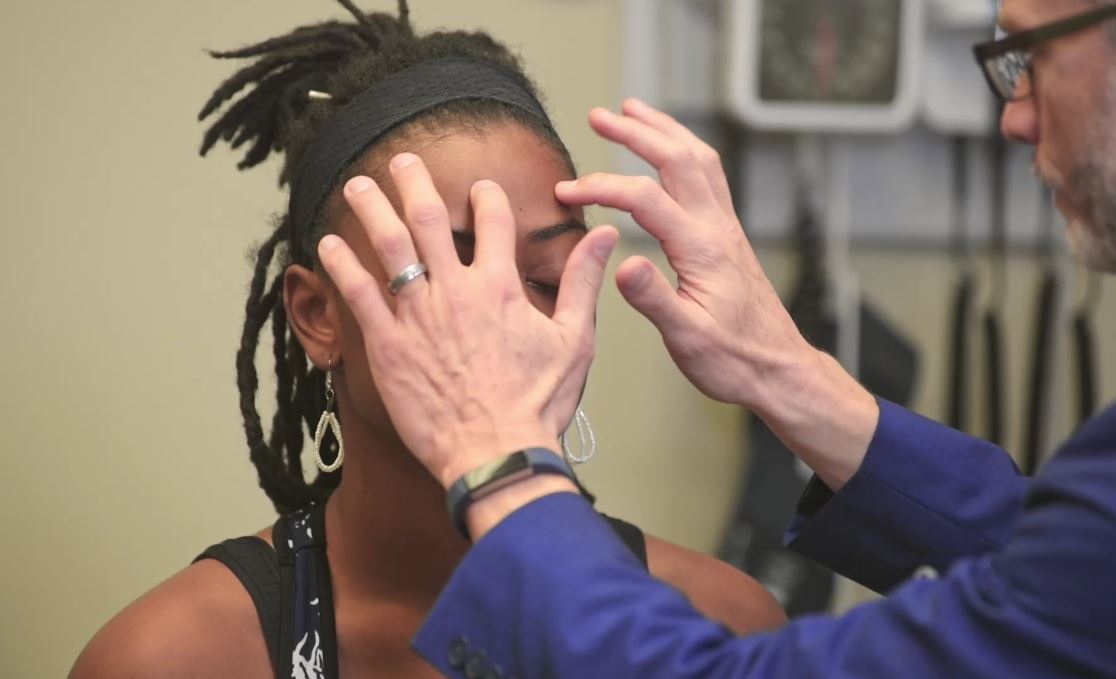Playlist
Show Playlist
Hide Playlist
Patient Introduction and Review of Head and Neck Anatomy
-
Slides Physical Exam Head and Neck Introduction.pdf
-
Reference List Physical Examination.pdf
-
Download Lecture Overview
00:00 Alright, so let's review the case of a patient with sore throat. So this is a 34-year-old woman who is presenting to her physician with a sore throat that has been worsening for the last 2 days. Her 4-year-old daughter has recently had similar symptoms. So certainly right off the bat I'm thinking that this is likely infectious, we have a sick contact in the house, and the presentation of sore throat over 2 days leads me towards infection. However, we should really review the complete structure and anatomy of what we're going to be examining because that may lead us towards thinking about some other etiologies as well. So we're going to talk about the overall structure of the sinuses and the bones of the skull. We're going to review some lymph nodes and how we can distinguish from infection versus malignancy. We'll be examining the ears, the nose, the oral cavity, and the thyroid. First off, it's important to know the basic anatomy of the skull remembering where the frontal bone is, zygomatic bones are actually some of the more common bones of the face that are fractured as well as the nasal bone. And then we have the maxillary portion of the frontal part of the face and the mandibular portion and certainly folks who have issues with a trigeminal nerve as we'll discuss and then on neurologic exam similarly have V1 and V2 and V3 broken up by the frontal bones, the maxillary bones, and the mandibular bones in a similar fashion. The sinuses as well in terms of being able to palpate or percuss over sinuses, all we have access to is the frontal sinus. More posteriorly is the ethmoid and sphenoid sinuses which we don't really have access to. Otherwise, we can tap on the maxillary sinuses as we'll discuss. In terms of the lymph node exam, we're going to want to be able to tease apart whether the lymph nodes are simply reactive in the setting of infection or if there are more concerning findings that would suggest the beginnings of a malignancy. We're also going to be talking about different types of ear infections starting off with otitis media involving problems with the middle ear and trying to compare and contrast that with patients who have an external ear infection of the external acoustic meatus. We're going to be looking for exam findings that can help us to distinguish between conductive hearing loss and sensorineural hearing loss. In terms of nose anatomy, remember that the nasal turbinates are broken up into 3 groups; the superior, the middle, and the inferior and they are directly perpendicular to the plane of the face rather than being upwards and pointing towards the eye sockets. When you're examining the turbinates, you may find evidence of polyps which sometimes we see in aspirin-exacerbated respiratory disease. You may be seeing some evidence of an infection with some nasal discharge. And then looking at the nasal mucosa, it may be boggy or erythematous depending upon what's going on as well. Moving on to the oral cavity, we'll be looking at the hard and soft palate. We'll be looking in the back of the throat to see if there are signs of allergic rhinitis with some postnasal drip or cobblestoning in the back of the throat. Anemia can also be detected through looking at the gingiva and looking for other ancillary findings that suggest a low hemoglobin. Pharyngitis, we'll try and distinguish between viral versus bacterial pharyngitis. The latter of which more often would have tonsillar exudates. And now we're going to briefly review the anatomy of the thyroid gland. 03:41 Remember that the thyroid gland is actually not attached to the thyroid cartilage and we'll talk about, on the physical exam, how to locate where the thyroid is best found. The structure of the thyroid gland, if it's enlarged you can actually end up having compression of the small airways or potentially even at the great vessels. And you're also going to be looking for systemic manifestations of thyroid disease and on palpation potentially just trying to identify small nodules within the gland itself. So returning to our case, there are a lot of different things that could present in this 34-year-old woman with sore throat. Perhaps it's just something straightforward like pharyngitis, streptococcal most notably or viral, maybe she has allergic rhinitis with a postnasal drip or potentially otitis media that is causing referred pain to the back of the throat. Either way, we're going to need to use our physical exam to tease apart what exactly is going on with our patient.
About the Lecture
The lecture Patient Introduction and Review of Head and Neck Anatomy by Stephen Holt, MD, MS is from the course Examination of the Head and Neck Region.
Included Quiz Questions
Which sinus area(s) may be percussed on physical exam?
- Frontal and maxillary
- Ethmoid
- Sphenoid
- Maxillary
Customer reviews
5,0 of 5 stars
| 5 Stars |
|
5 |
| 4 Stars |
|
0 |
| 3 Stars |
|
0 |
| 2 Stars |
|
0 |
| 1 Star |
|
0 |




